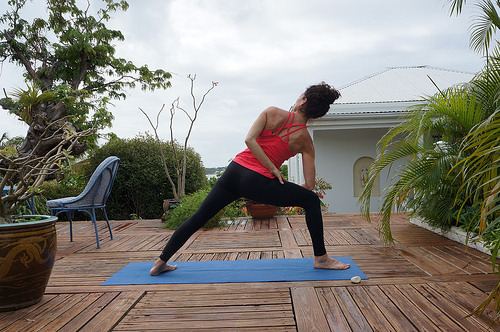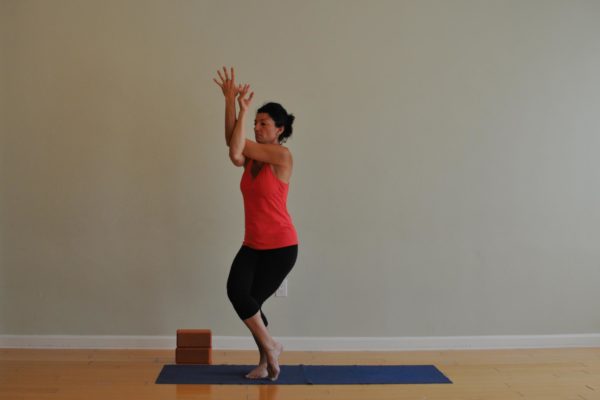I’ve been teaching for a long time now and I’ve noticed one of the factors that drive practitioners on the mat. It’s something we all deal with in our lives off the mat too: it’s what everyone else is doing. Did you ever hear your mother say when you were young, “Well, I know that your friend so and so is doing that, but I don’t want you to do that. If your friend was jumping off a bridge, would you do that too?” That was mom’s way of encouraging you to do what’s right for you.
I recently taught a class and there was an entire row of students who double wrapped their upper arm in Side Angle, right on cue, after the student at the end of the row took the double bind:Â

In the picture above, I am not taking the double bind but imagine my right hand sliding under my right thigh and grabbing for my left hand.
Now, I get it. Students learn by watching. They learn by listening too but they, in large part, learn by watching what everyone else is doing and figuring, “Well, that must be the right way to do it. ” This is the challenge in teaching public classes. You have a very limited ability to customize the practice for each person. As a teacher, you have to use your judgment and lean on your experience to guide you as to what instructions to present, in such a way that you will provide the greatest good to the most people in the class. When I teach, I like to share general tips that speak to what’s happening in the class. So, in the case of the double binding row, I mentioned to the class, “If you’re double binding and you’re facing the floor instead of the wall in front of you, consider loosening the bind or grabbing a strap instead. Facing the floor in this pose gets in the way of the opening of the upper shoulder which is a huge benefit of this posture.”
Anatomically speaking, the double bind gives the student tremendous leverage to create what’s called torque on the shoulder joint. Torque is defined as applying force to an object on an axis. In this pose, the axis is the spine and we’re creating rotational force around the spine through the twist. As we move into the bind, depending on the degree of flexibility in our shoulder’s external rotators, we may not be able to keep the integrity of the pose. This means that instead of staying upright ( as I am in the picture above ), the student will start to fall forward towards the floor. It’s the body’s way of looking for a way out, looking for a way to stay somewhat in the pose but knowing that it has to give somewhere. You just don’t want the “give” to happen in the shoulder joint.
Another pose where we see this is in Eagle:

If I take my right leg here and wrap the lower shin around the standing leg, I create the same issue of torque as in the example above. The goal from the student’s perspective is a little different; here, they may be trying to center their hips but with the double wrap around the shin and the thighs being so close together (adducting) if I have any limitation in my hip’s external rotators, the knee joint will take the brunt of it.
Joints are moveable parts of the body but in order for them to stay healthy, we need to move them in a healthy way. I wonder why we even suggest double binding to students in group classes because quite frankly, many students don’t understand the risk to the joint. So, if there’s general risk, why would we as teachers suggest it? For many of us, it’s what we were taught. Also, these variations are part of the history of yoga.
Let me close by saying this: any movement that any student takes, and the risk it poses, is dependent on many things. It will depend on the degree of both flexibility and strength, the awareness of the student, their level of experience, their knowledge of anatomy (yes, it’s true!), their overall conditioning, whether they have worked individually with a teacher on their practice versus only in group classes, and many other factors. This is why it’s impossible to say that if you practice these poses in the way described above, it will most definitely lead to problems. But again, if you are teaching group classes, your knowledge of any of those factors in regards to your students is most likely not very good. Unless you see the same students in your classes all the time ( which is possible ) you are most likely seeing new students or students that come and go all the time. Our job, I believe, is to present things in such a way that we decrease the risk to all but at the same time, let people make their own choices.
If you want to learn about the anatomy of yoga, feel free to check out my online courses:
Bare Bones Yoga Online Anatomy Courses
You can also download my free e book on yoga anatomy on Amazon here:
Key Aspects of Anatomy for Yoga Teachers
The book has been downloaded over 2,000 times and I am excited that the topic resonates with people.
As always, practice from your heart.Â
